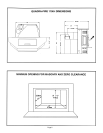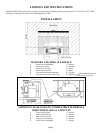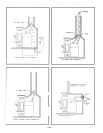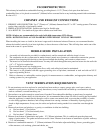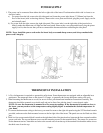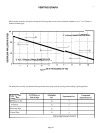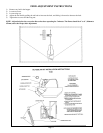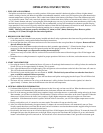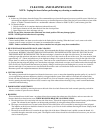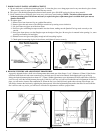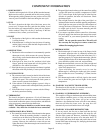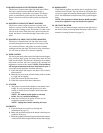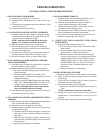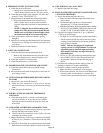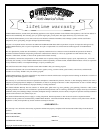8. THERMOSTAT WILL NOT START UNIT
A. Check the power to the insert.
1. Unplug for 10 seconds and then plug back in. The
exhaust blower should come on. If it does, go to C.
B. Check the power supply (plug should be 120 volts, fuse
should be 7 amp, 120 volt [AGC-7]).
C. The thermostat or the thermostat wiring maybe faulty.
1. Disconnect the thermostat wires from the insert.
Make a jumper wire in order to create a manual
bypass to determine if the insert or the thermostat is
faulty.
NOTE: Unplug the insert while hooking up the
jumper wire. Plug the insert back in and the unit
should come on and light. If the unit lights, check
the thermostat and the wires connecting them.
D. Check reset button to make sure current is passing
through it.
E. Snap disc #2 would bypass the thermostat if an overheating
situation occurs. The snap disc should reset itself once it
cools down.
F. Check the control box (consult dealer).
9. UNIT FAILS TO SHUT OFF
A. Check the thermostat and the thermostat wires.
1. Remove one of the thermostat wires from the insert;
the insert should go into a normal shutdown cycle.
B. Check the control box (consult dealer).
C. Check the junction box (consult dealer).
10. SMOKE FROM THE CONVECTION AIR OUTLET
A. Check the exhaust blower housing and all venting
connections.
B. Most problems with smoke in the house are the result of a
poor venting system.
11. CONVECTION BLOWERS KEEP RUNNING OR FAIL
TO START
A. Snap disc #1 may need to be replaced.
B. Check the wire connections on snap disc #1 and the
convection blowers to be sure a good connection is being
made.
C. Check the convection blowers.
12. INSERT CYCLES ON AND OFF, THERMOSTAT
ALWAYS ON
A. Check that snap disc #1 is coming on and turning the
convection blowers on. If not, snap disc #2 could be
bypassing the thermostat until the snap disc cools and
resets itself.
13. LARGE FIRE, ASH BUILDUP AND DIRTY GLASS
A. Clean the firepot. Check the firepot gasket for a good seal
between the firepot and firebox surface.
B. Visually check the cleanliness of the firebox, the heat
exchanger and venting system.
C. Reduce the feed rate, if necessary, to maintain a fire height
of about 4" to 6" (100mm to 153mm) above the top of the
firepot.
D. If the above do not help, an air adjustment may be needed.
Open more to increase air to help even the air to fuel ratio.
14. UNIT BURNING, NO CALL LIGHT
A. Replace light bulb (#85 lamp).
15. STOVE IGNITES THEN GOES OUT, LIGHTS STILL ON
= NUISANCE SHUTDOWN
A. Inspect the thermocouple and the cover.
1. Make sure that the thermocouple end and the cover
make contact.
2. The thermocouple and the cover should extend
approximately 1” (25mm) into the firepot.
3. Push the reset button. When the thermocouple reaches
200°F (93°C) the GREEN LIGHT will come on, and
at 1000° F (538°C) the RED LIGHT will come on.
B. Check the fire height. It should be 4” to 6" (100mm to
153mm) out of the firepot.
1. Too high of a fire will lower the vacuum in the firebox
and the vacuum switch may turn off the feed system,
resulting in total shutdown or feed system shutdown
until vacuum is regained.
NOTE: This may also happen in complicated
venting systems, or at high altitudes. Use the feed
adjustment plate to slow fuel input and reduce
flame height. If this does not help, check the air
adjustment plate.
2. Too low of a fire will let the firepot temperature drop
below 1000°F (538°C) and will turn the insert off.
Increase fuel, check for sawdust and bridging of
pellets.
C. Check the heat exchanger and the venting system for
buildup or restriction (cleanout ash buildup).
D. Check the vacuum switch for proper operation.
1. Make sure that the vacuum hose is not clogged.
2. With normal operation, the vacuum switch should shut
the feed system off when the door is opened, and
restart the feed system when the door is closed again.
Page 18



